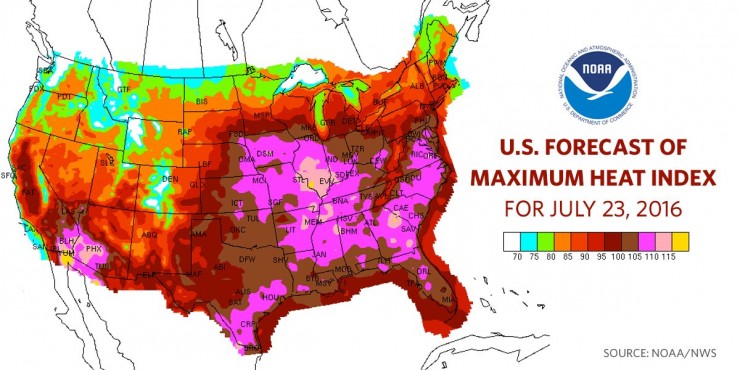Editor’s Note: A heat wave is expected to affect our area this week. This blog post by Amy Pope, White House deputy homeland security advisor, contains information and resources that you may find useful in staying safe during the extreme heat.
By Amy Pope
As a heat wave spreads across the country this week, the federal government is working overtime to help state, regional, tribal, and local communities prepare for potential extreme-heat events.
Extreme heat affects everybody—our family, friends, and neighbors. Our nation’s most vulnerable include the elderly, children, emergency responders, outdoor workers, low-income households, athletes, and even our pets. In extreme heat conditions, simple daily activities like walking a dog (in my case, it’s our golden doodle Coco!), going for a jog, or spending time outside with the kids can be dangerous.
That’s why we’re taking the threat of extreme heat so seriously. We know if we are prepared to respond to extreme heat, we can dramatically reduce the risks to ourselves and our loved ones. The majority of heat-related deaths and illnesses are preventable. We can make our communities more prepared, recognize the early warning signs of heat stroke or exhaustion, and spread the word about practical solutions and resources that are available in the face of these severe conditions.
- Older adults, children, and people with chronic medical conditions are more prone to the impacts of excessive heat. When it’s extremely hot outside, check in on those at risk at least twice a day and observe them for signs of heat exhaustion, including heavy sweating, cold, pale skin, nausea, or vomiting. For heat stroke, you may observe high body temperature, hot, red, dry or moist skin, or even possible unconsciousness. Pay special attention to the impact of heat on infants and young children—who are not only less efficient at regulating heat internally than adults, but of course, have to rely on others to stay safe.
- Stay cool indoors. Air-conditioning is the number one protective factor against heat-related illness and death. When the weather becomes extremely hot, and if air conditioning is not available at home, spend time in air-conditioned locations, including shopping malls, public libraries, or public health sponsored heat-relief shelters that may be established in your area. Athletes should avoid over exerting themselves, and in any environment, be sure to move at a comfortable pace and wear appropriate clothing.
- And regardless of your activity level, stay hydrated. Drink cool, nonalcoholic beverages and increase your fluid intake. Do not perform heavy exercise in an extreme heat environment, and remain hydrated while exposed.
Average temperatures across the country are at historic highs, which means we’ll have more hot days and more heat waves this summer. We need to be ready. More information on temperature predictions and toolkits to help you prepare for heat waves can be found here.
Learn how to recognize health problems related to extreme heat and what to do in the event of an emergency in this Centers for Disease Control and Prevention guide.
Finally, download and use the free FEMA app, which helps prepare families for extreme weather and other hazardous events. The app is available on the Apple App Store and on Google Play.
Additional resources on extreme heat, including information about understanding the risk, case studies, and heat health tools, can be found in the National Integrated Heat Health Information System toolkit.
Have a great summer and stay cool!
Amy Pope is deputy homeland security advisor to President Barack Obama.






Leave a Reply